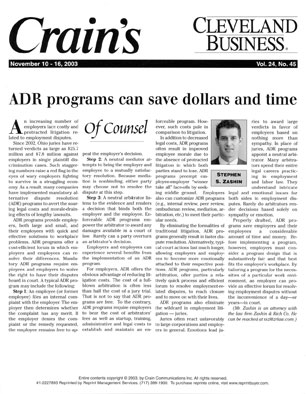
Z&R Press
Press and Media
Law360
Mocktails Seen As Key Ingredient For Holiday Party Inclusivity
November 8, 2023
Cleveland Metropolitan Bar Journal
Women in Law
April 2020
Smart Business Cleveland
2017 Smart Business Family Business Achievement Awards
September 2017
Crain's Cleveland Business
Ohio Employers Confront Marijuana Use
July 22, 2017
Sports Illustrated
Lane Johnson's Bold Move To Sue His Own Union Is Rare, But Not Unprecedented
January 11, 2017
Law360
Packers Player Drops NFL Drug Suspension Dispute
December 19, 2016
Sports Business Daily
NFL, NFLPA Appoint Das As Third Arbitrator In Michael Pennel Lawsuit
December 5, 2016
Sports Business Journal
Eagles Lineman Challenges NFL and NFLPA in NLRB Filings
December 5, 2016
Law360
Eagles Lineman Says Suspension Violates Federal Labor Law
November 29, 2016
The Business of Sports with Andrew Brandt
RTAB #30: Lane Johnson's Legal Team (Audio Interview)
November 29, 2016
BNA's Health Law Reporter
Surprise! The NLRB Says You Just Might Be a 'Joint Employer'
September 24, 2015
BNA's Health Law Reporter
NLRB Adopts New Joint Employer Standard; Ruling Could Affect Health-Care Industry
September 3, 2015
BNA's Health Law Reporter
Challenge to NLRB Election Rule Fails; Employers Urged to Prepare New Game Plan
June 11, 2015
American Bar Association Section of Labor and Employment Law
Member Spotlight: George S. Crisci
April 13, 2015
Crain's - Article and Video
Zashin & Rich embraces Cleveland roots and rock 'n' roll heritage
November 16, 2014
BNA's Health Law Reporter
Justices Reject NLRB Recess Appointments; Significant Health Care Decisions in Limbo
July 10, 2014
BNA's Health Law Reporter
The EEOC and FTC Turn Up the Heat on Employer Background Checks
April 2014
Crain’s
Zashin & Rich move marks big milestone
for E&Y Tower
November 2013
Cleveland.com
Zashin & Rich law firm leases last full floor of Ernst & Young Tower at Flats East Bank project
November 2013
CCH Employment Law Daily
NLRB NEWS - Controversy Erupts Over NLRB Recess Appointments
January 2012
Crain’s
Companies should consider coverage against employee-related claims
By Stephen Zashin | July 2004
Crain’s
ADR programs can save dollars and time
By Stephen Zashin | November 2003
COSE Update: Legal Ease
One Size Does Not Fit All
(Employment Practices Liability Insurance)
By Stephen Zashin
COSE Update: Legal Ease
Noncompete Agreements
By Michele Jakubs
COSE Update: Legal Ease
Ohio's 'Baby COBRA' Law
By Helena Oroz
Crain's
“ADR programs can save dollars and time”
November 10-16, 2003 | By Stephen Zashin | Download PDF of Article

An increasing number of employers face costly and protracted litigation related to employment disputes.
Since 2002, Ohio juries have returned verdicts as large as $25.7 million and $7.8 million against employers in a single plaintiff discrimination case. Such staggering numbers raise a red flag in the eyes of wary employers fighting to survive in a struggling economy. As a result, many companies have implemented mandatory alternative dispute resolution (ADR) programs to avert the soaring legal costs and morale-draining effects of lengthy lawsuits.
ADR programs provide employers, both large and small, and their employees with quick and effective solutions to workplace problems. ADR programs offer a cost-efficient forum in which employers and employees can resolve their differences. Mandatory ADR programs require employees and employers to waive the right to have their disputes heard in court. A typical ADR program may include the following:
Step 1: An employee (or former employee) files an internal complaint with the employer. The employer then determines if the complaint has any merit. If the employer denies the complaint or the remedy requested, the employee remains free to appeal the employer's decision.
Step 2: A neutral mediator attempts to bring the employer and employee to a mutually satisfactory resolution. Because mediation is nonbinding, either party may choose not to resolve the dispute at this step.
Step 3: A neutral arbitrator listens to the evidence and renders a decision that binds both the employer and the employee. Enforceable ADR programs empower the arbitrator to award any damages available in a court of law. Rarely can a party overturn an arbitrator's decision.
Employers and employees can experience several benefits from the implantation of an ADR program.
For employers, ADR offers the obvious advantage of reducing litigation costs. The cost of a full blown arbitration is often less than half the cost of a jury trial. That is not to say that ADR programs are free. To the contrary ADR programs require employers to bear the cost of arbitrators' fees as well as startup, training, administrative and legal costs to establish and maintain an enforceable program. However, such costs pale in comparison to litigation.
In addition to decreased legal costs, ADR programs often result in improved employee morale due to the absence of protracted litigation in which both parties stand to lose. ADR programs preempt employee-employer "winner take all" face-offs by seeking middle ground. Employers also can customize ADR programs (e.g., internal review, peer review, ombudsman review, mediation, arbitration, etc.) to meet their particular need.
By eliminating the formalities of traditional litigation, ADR programs generally result in faster dispute resolution. Alternatively, typical court actions last much longer, allowing employers and employees to become more emotionally attached to their respective positions. ADR programs, particularly arbitration, offers parties a relatively quick process and efficient forum to resolve employment related disputes, to reach closure and to move on with their lives.
ADR programs also eliminate the wildcard in employment litigation—juries.
Juries often react unfavorably to large corporations and employers in general. Emotions lead juries to award large verdicts in favor of employees based on nothing more than sympathy. In place or juries, ADR programs appoint a neutral arbitrator. Many arbitrators spend their entire legal careers practicing in employment and labor law. They understand intricate legal and emotional issues for both sides in employment disputes. Rarely do arbitrators render decisions based solely on sympathy or emotion.
Properly drafted, ADR programs save employers and their employees a considerable amount of time and money. Before implementing a program, however, employers must consider a program design that is substantively fair and that best fits the employer's workplace. By tailoring a program for the necessities of a particular work environment, an employer can provide an effective forum for resolving employment disputes without the inconvenience of a day—or years—in court.
(Mr. Zashin is an attorney with the law firm of Zashin & Rich Co. He can be reached at ssz@zrlaw.com.)
